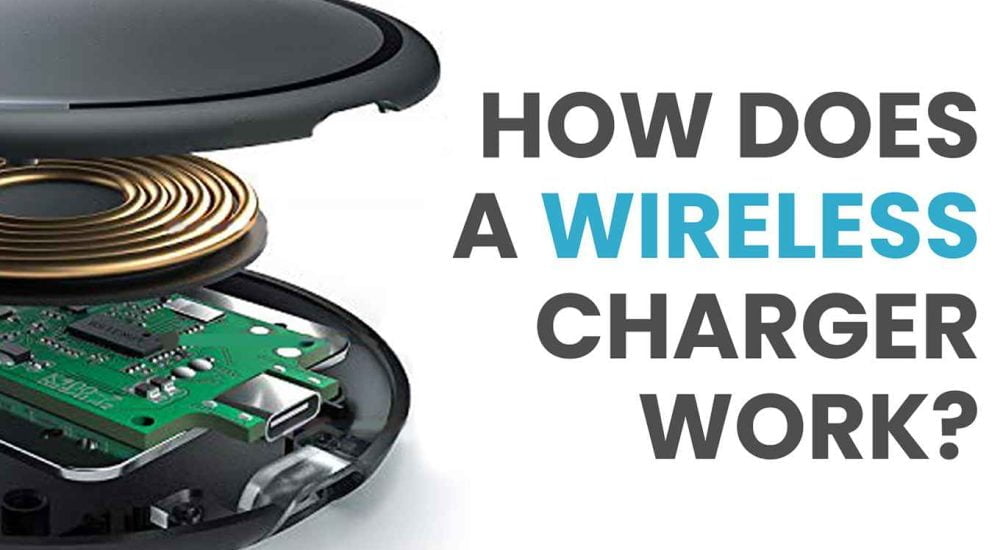
Wireless chargers are gaining popularity, especially in the sectors of healthcare, automobiles, electronics, etc. Because it promises more mobility and technological advancements that can enable devices to gain power without using a wired charger.
What is Wireless Charging?
Wireless charging, also known as Inductive Charging or Qi Charging, is an advanced charging method that removes the need for cables and adapters. It uses electromagnetic fields that transfer energy between two coils. One coil is in the charging pad or the base station and the other coiling is in the device such as Smartphones, earbuds or smartwatches being charged. When such coils are put on top of one another, they transmit power from one coil to another.
What goes on inside a Wireless Charger?
Coil Design
Both the charging pad and the device to be charged contain a coil of wire. These charging coils are usually made of copper and are designed to resonate at the same frequency, which is typically in the radio frequency (RF) range.
Electricity Generation
The charging pad is connected to a power source, such as a wall outlet or a USB port. When you plug in the pad, it converts the AC (alternating current) electricity from the power source into high-frequency AC current.
Electromagnetic Field Creation
This high-frequency AC current running through the coil in the charging pad generates an electromagnetic field around the pad. The coil in the device to be charged, which is typically smaller, and is designed to pick up this electromagnetic field.
Electromagnetic Induction
When the coil in the device is brought into proximity with the charging pad, the changing magnetic field induces a current in the coil of the device according to Faraday’s law of electromagnetic induction. This induced current is then converted into DC (direct current) electricity, which is used to charge the device’s battery.
Charging Process
The device continues to draw power from the charging pad as long as it remains within the effective charging range. Once the battery is fully charged or the device is removed from the pad, the charging process stops.
Safety Features
Wireless charging systems typically incorporate safety features like temperature monitoring and overcharge protection to prevent overheating and damage to the device or the battery.
Two Main Standards for Wireless Charging
Qi Standard
The Qi standard, created by the Wireless Power Consortium (WPC), is the most extensively used wireless charging standard for smartphones and other small electronic devices like Smartwatches and earbuds. Top smartphone brands like Apple, Samsung, and Google, use the Qi standard technology.
PMA Standard
The Power Matters Alliance (PMA) created a wireless charging standard as well. However, it is not as popularly used than Qi.
Benefits of Using a Wireless Charger
Convenience
One of the primary advantages of wireless chargers is the convenience they offer. You don’t need to fumble with cables or adapters. Place your device on the charging pad, and it will start charging. This makes it especially convenient for charging devices like smartphones and smartwatches overnight or during the day without needing to plug and unplug them repeatedly.
Reduction in cable clutter
Wireless chargers help reduce cable clutter on your desk, nightstand, or workspace. Since there’s no need for multiple charging cables, your space looks cleaner and more organized.
Ease of use
Wireless charging is incredibly user-friendly. It’s as simple as placing your device on the charger, and it begins charging immediately. This ease of use makes it accessible for people of all ages and tech proficiency levels.
Compatibility
Many modern smartphones and other devices are compatible with wireless charging technology, including Qi wireless charging. This means you can use a single wireless charger for multiple devices, making it versatile and cost-effective.
Durability
Wireless chargers don’t require constant plugging and unplugging, which can cause wear and tear on charging ports and cables. This can help extend the lifespan of your devices since the charging port is a common point of failure in many gadgets.
Fast Charging Capabilities
Wireless charging technology has evolved to offer faster charging speeds. Some wireless chargers support fast charging standards like Qi 1.2, which can charge your device as quickly as or even faster than some wired chargers.
Safety Features
Wireless chargers often include safety features like overheat protection, foreign object detection, and short-circuit protection to ensure that your device remains safe during charging.
Aesthetics
Wireless chargers come in various designs and materials, allowing you to choose one that matches your style and complements your workspace or home decor.
Portability
Wireless chargers are usually compact and easy to carry, making them suitable for travel or using in various locations.
Future-proofing
As more devices adopt wireless charging technology, investing in a wireless charger can help future-proof your charging setup. You won’t need to worry about having the right cable for a specific device.
Wireless charging is convenient because it eliminates the need for an adapter and cable, making it easier to charge devices without dealing with tangled wires. However, the efficiency of wireless charging can vary depending on factors like the distance between the coils, alignment, and the power source’s output. Advances in technology continue to improve wireless charging speed and efficiency. Making it an increasingly popular choice for many electronic devices.
No Wireless Charging Feature?
Here is a Solution
If your smartphone does not have the wireless charging feature, you can utilize a specially designed charger cover that includes built-in wireless charging technology. The case connects with your phone through a connector included within the case. Because this technique is challenging, it is not commonly used. The main benefit of wireless charging is that you no longer need to plug in a charger.

